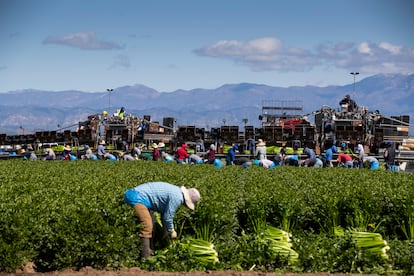California minimum wage: What you should know about the change in 2024
Although the new wage policy could benefit workers, some companies have decided to close locations and lay off employees in response


Since 2017, the state of California began the process to increase its minimum wage in stages to reach $15 in 2022, which involved a slight increase each year. After that figure was reached, an annual adjustment is made each year according to the national Consumer Price Index for Urban Wage Earners and Employees (CPI-W). Even if there is a negative change in the index, the wage cannot decrease. On the other hand, its annual increase is capped at 3.5%, which cannot be paused by the Governor in office, but can be accelerated in years when inflation is high and the CPI-W exceeds 7%. Here’s an explanation of the current state of the wage rate and the immediate impacts it has had on the labor landscape.
What is the minimum wage in California in 2024?
The minimum wage in California for all employers starting January 1, 2024, is $16 per hour. Fast food restaurant employers are required to provide a minimum wage of $20 per hour on April 1, while the wage for healthcare facilities also increased on June 1 (it can be paid from between $18 to $23 per hour). This applies to both adult and junior employees, regardless of the size of the company (unlike previous years). The California Department of Industrial Relations clarifies that, while most employees in the State must be paid the minimum wage, there are some exceptions.
Although the State of California determines the minimum wage, some cities and counties have higher minimum wages. For example, while Los Angeles has a minimum wage of $16.78, Emeryville, near Oakland, has a minimum wage of $18.67. A list of wages by location can be found on the UC Berkeley Labor Center website. According to the Department of Industrial Relations, when there is a conflict in wage laws, the rule is that the law that most benefits workers should be used.
What are the exceptions?
There are some exceptions to the minimum wage law. Certain employees such as outside salespersons, family members of the employer (such as parents, children and spouse) and apprentices in certain training programs may receive a lower wage. Similarly, apprentice employees in their first 160 hours of employment in an area in which they have no experience may receive 85% of the minimum wage.
Some employers may hire disabled individuals below the minimum wage under certain conditions, however, they may only do so until January 1, 2025.
Workers’ rights
Employees cannot agree to work for less than the minimum wage, regardless of individual agreements or through negotiations with others. The minimum wage is a “non-negotiable right” that employers must grant. Tips cannot count toward the minimum wage.

What to do if the employer does not pay the minimum wage?
Workers can pursue several legal routes to receive unpaid wages, in addition to obtaining damages and penalties. One option may be to file a wage complaint with the Labor Commissioner’s Wage Claims Adjudication Unit, or create a Labor Law Violation report. They may also file for arbitration if the employment agreement permits or requires it, or alternatively, file suit in court for wage recovery. For assistance, you can check the Labor Commissioner’s website or go to local offices.
Workers have legal protections against retaliation by employers in the event they make wage complaints, such as reduction in hours or demotion, employees may file a complaint of retaliation or discrimination with the Labor Commissioner’s Office, or initiate a lawsuit.
What effects has the increase in the minimum wage had?
The recent increase in the minimum wage for fast food workers is beginning to show its impact on the sector. This change, aimed at chains with more than 60 establishments, is intended to offer better wages to workers, but it also provokes significant economic adjustments. Companies have responded with staff reductions, subcontracting services to third-party delivery applications, price increases and cuts to operating hours. For example, Rubio’s Coastal Grill, a Mexican food chain, has announced the closure of 48 restaurants, which it attributed to the “rising cost of doing business in California.” This comes after the company had already reduced its workforce due to previous economic pressures and competition. Smaller companies are the most affected because they do not have economies of scale like larger competitors.
On the other hand, the wage hike could prompt companies to focus on issues such as automation and efficiency measures, such as installing ordering kiosks to reduce reliance on human labor. The fast food sector, traditionally a source of entry-level jobs for young workers, now offers fewer opportunities due to these economic pressures, which could have repercussions down the road for the labor market. This contributes to higher unemployment rates in California compared to national figures, highlighting the complex outcomes of these wage policies.
Sign up for our weekly newsletter to get more English-language news coverage from EL PAÍS USA Edition
Tu suscripción se está usando en otro dispositivo
¿Quieres añadir otro usuario a tu suscripción?
Si continúas leyendo en este dispositivo, no se podrá leer en el otro.
FlechaTu suscripción se está usando en otro dispositivo y solo puedes acceder a EL PAÍS desde un dispositivo a la vez.
Si quieres compartir tu cuenta, cambia tu suscripción a la modalidad Premium, así podrás añadir otro usuario. Cada uno accederá con su propia cuenta de email, lo que os permitirá personalizar vuestra experiencia en EL PAÍS.
¿Tienes una suscripción de empresa? Accede aquí para contratar más cuentas.
En el caso de no saber quién está usando tu cuenta, te recomendamos cambiar tu contraseña aquí.
Si decides continuar compartiendo tu cuenta, este mensaje se mostrará en tu dispositivo y en el de la otra persona que está usando tu cuenta de forma indefinida, afectando a tu experiencia de lectura. Puedes consultar aquí los términos y condiciones de la suscripción digital.
More information
Archived In
Últimas noticias
Most viewed
- Reinhard Genzel, Nobel laureate in physics: ‘One-minute videos will never give you the truth’
- Oona Chaplin: ‘I told James Cameron that I was living in a treehouse and starting a permaculture project with a friend’
- Pablo Escobar’s hippos: A serious environmental problem, 40 years on
- Why we lost the habit of sleeping in two segments and how that changed our sense of time
- Chevy Chase, the beloved comedian who was a monster off camera: ‘Not everyone hated him, just the people who’ve worked with him’










































